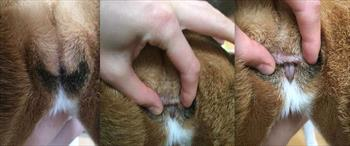18. Disorders of vagina and vulva -vaginal prolaps, vulval discharge, vaginitis, tumours
1/37
There's no tags or description
Looks like no tags are added yet.
Name | Mastery | Learn | Test | Matching | Spaced |
|---|
No study sessions yet.
38 Terms
What is vaginal prolapse?
Oedema, hyperplasia and protrusion of the vagina, hormone induced by oestrogen stimulation
What can vaginal prolapse lead to?
Vaginitis and cystitis
When does vaginal prolapse typically resolve?
As soon as oestrogen levels decline
Which bitches are predisposed to vaginal prolapse?
Young bitches in their second or third oestrus, brachycephalic breeds
What are the clinical signs of vaginal prolapse?
Mass protruding from vulva, slight vaginal discharge, reluctance or failure to breed
What are the three stages of vaginal prolapse?
Stage 1 (slight protrusion inside vulva lips), Stage 2 (moderate pear-shaped mass between vulvar lips), Stage 3 (huge oedematous mass protruding out)
What is a key difference between vaginal and uterine prolapse regarding timing?
Vaginal prolapse occurs during oestrus, while uterine prolapse occurs around parturition
How is vaginal prolapse diagnosed?
History (oestrus?), vaginal exam
What is the treatment for vaginal prolapse if it's not causing problems?
No treatment
How is protruding vaginal prolapse managed?
Keep clean and moist, antibiotic ointment and sugar (to reduce oedema)
What is the permanent correction for recurrent vaginal prolapse?
Ovariohysterectomy (OHE)
What is juvenile vulva (hidden vulva)?
A conformational issue where the vulva is partially or completely engulfed by skin folds

What can juvenile vulva lead to?
Perivulvar dermatitis, vaginitis, and cystitis
Which animals are predisposed to juvenile vulva?
Overweight, spayed females, medium to large breeds
What are the clinical signs of juvenile vulva, often related to secondary infections?
Licking, odour, incontinence, urinary tract infection (UTI) symptoms
How is juvenile vulva diagnosed?
Physical exam and urinalysis
What is the treatment for juvenile vulva?
Treat bacterial infections, weight loss, vulvoplasty if severe
What is juvenile vaginitis?
Vaginitis occurring before the first oestrus in puppies from 8 weeks of age
What is the typical clinical sign of juvenile vaginitis?
Mucoid/mucopurulent discharge
What is the usual outcome for juvenile vaginitis?
It typically resolves after the first oestrus
Is treatment generally recommended for juvenile vaginitis?
No
What are the two categories of vaginitis in intact adult females?
Primary and secondary
What are the potential primary causes of vaginitis in intact adult females?
Bacterial or viral (canine herpesvirus)
What are some potential secondary causes of vaginitis in intact adult females?
Hermaphroditism, anatomical problems, urinary problems, foreign bodies, pyometra, neoplasia, diabetes
What are the clinical signs of vaginitis in intact adult females?
Discharge, cystitis, perivulvar pruritus, licking, male attention outside oestrus
How is vaginitis in intact adult females diagnosed?
Excluding other causes of discharge, vaginal cytology, endoscopy, bacteriological swab, Brucella canis test
What is the treatment for vaginitis in intact adult females?
Treat underlying cause if secondary, antibiotics (careful of normal flora)
What is a characteristic of vaginitis in neutered adult females?
Can become chronic and difficult to cure, especially if neutered before first oestrus
What treatments may help vaginitis in neutered adult females?
Oestrogen, corticosteroids in severe cases
How common are tumours of the vagina and vulva compared to other reproductive tumours?
Second most common after mammary gland tumours
At what age are vaginal and vulvar tumours more common in bitches?
Older than 10 years
What percentage of vaginal and vulvar tumours are benign?
90%
What are some examples of benign vaginal and vulvar tumours?
Leiomyoma, fibroma, polyps, histiocytoma, melanoma
What are some examples of malignant vaginal and vulvar tumours?
Leiomyosarcoma, adenocarcinoma, squamous cell carcinoma (SCC), haemangiosarcoma
What is transmissible venereal tumour (TVT)?
A malignant, sexually transmitted tumour with cauliflower-like masses
What are the clinical signs of vaginal and vulvar tumours?
Bleeding or discharge, vulvar mass, dysuria, haematuria, tenesmus, licking, dystocia
How are vaginal and vulvar tumours diagnosed?
Vaginoscopy examination, fine needle aspiration (FNA) cytology, USG, X-ray
What is a key difference in the aetiology of vaginal prolapse versus uterine prolapse?
Vaginal prolapse is primarily hormonal (oestrogen), while uterine prolapse is mechanical (straining, pulling).